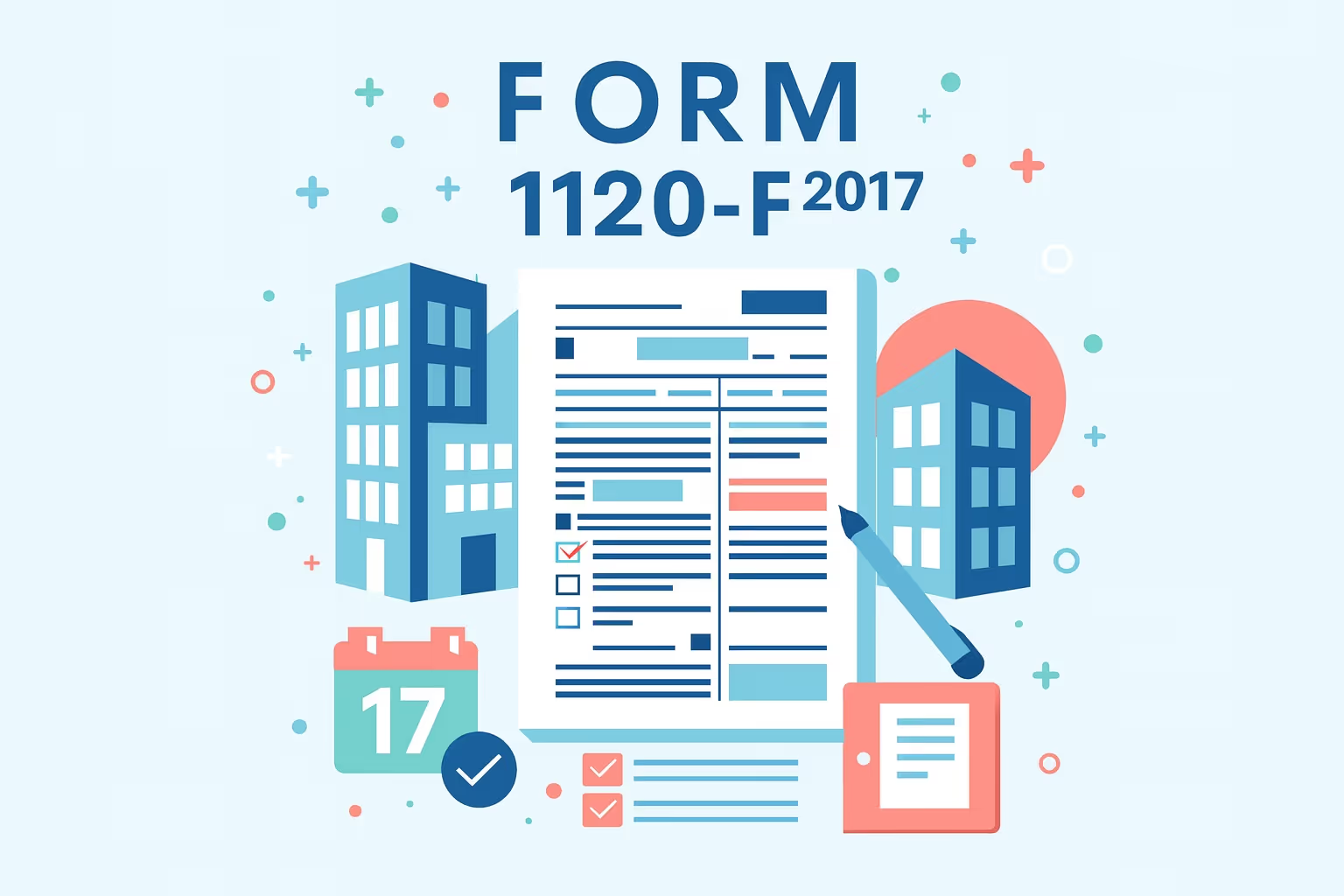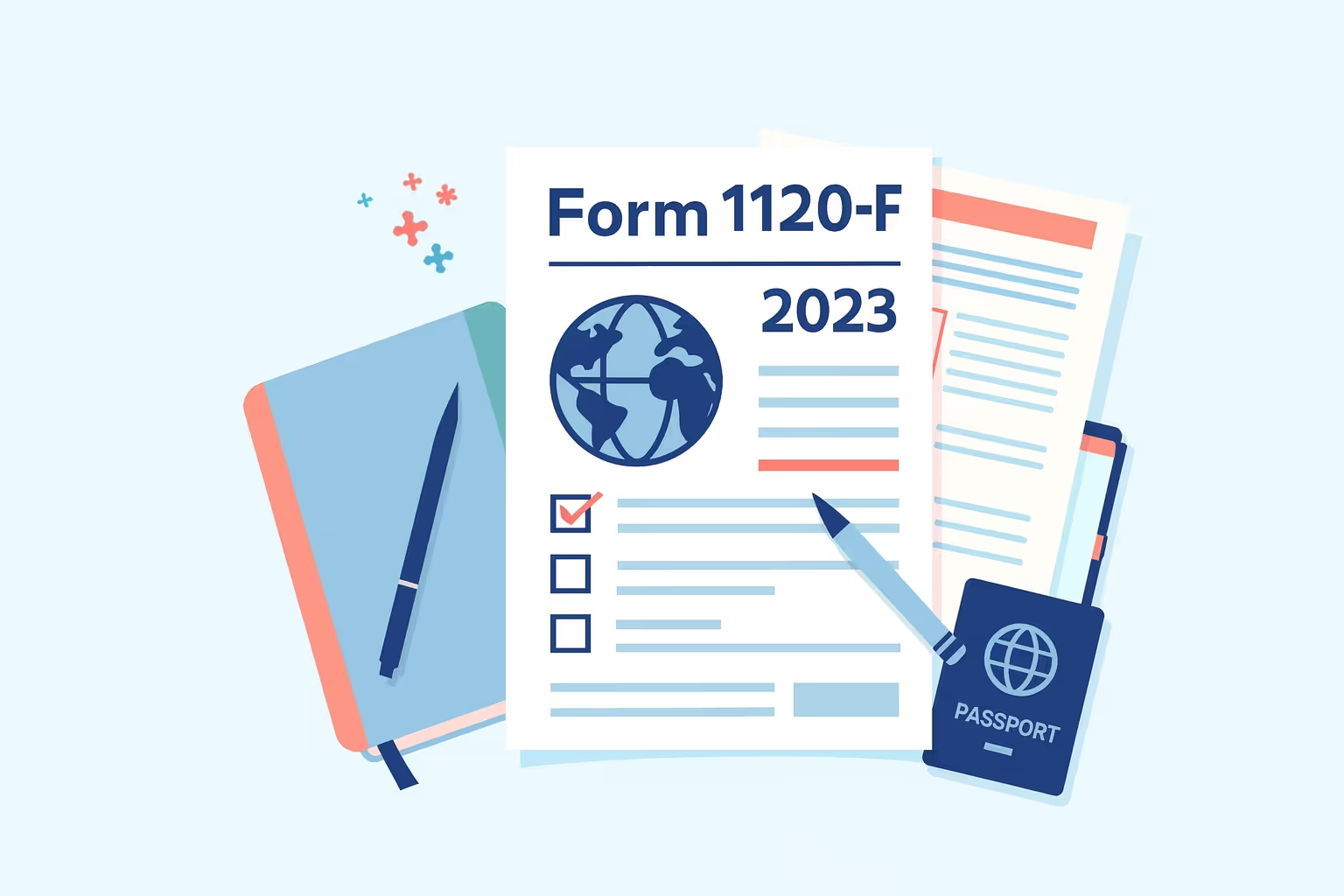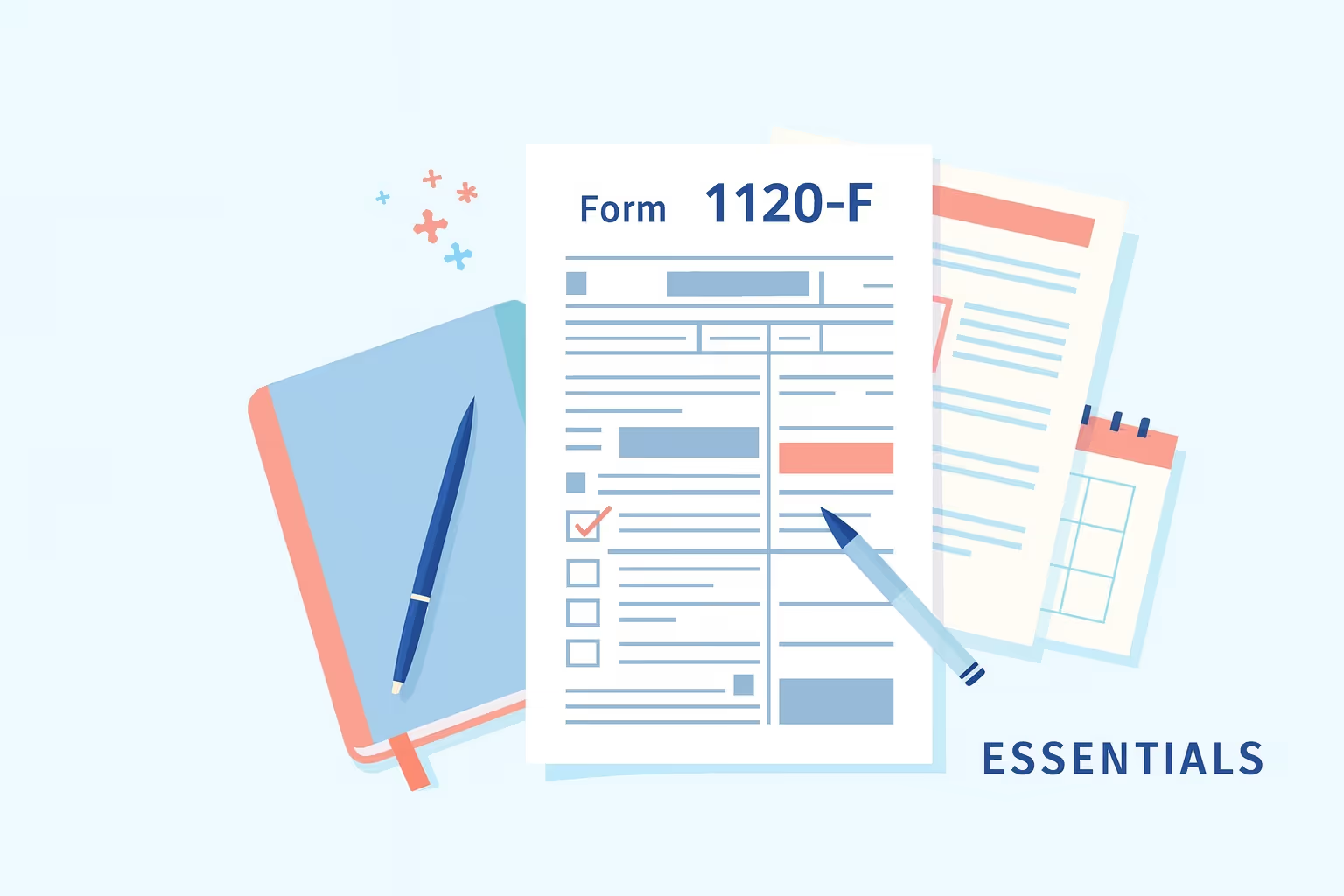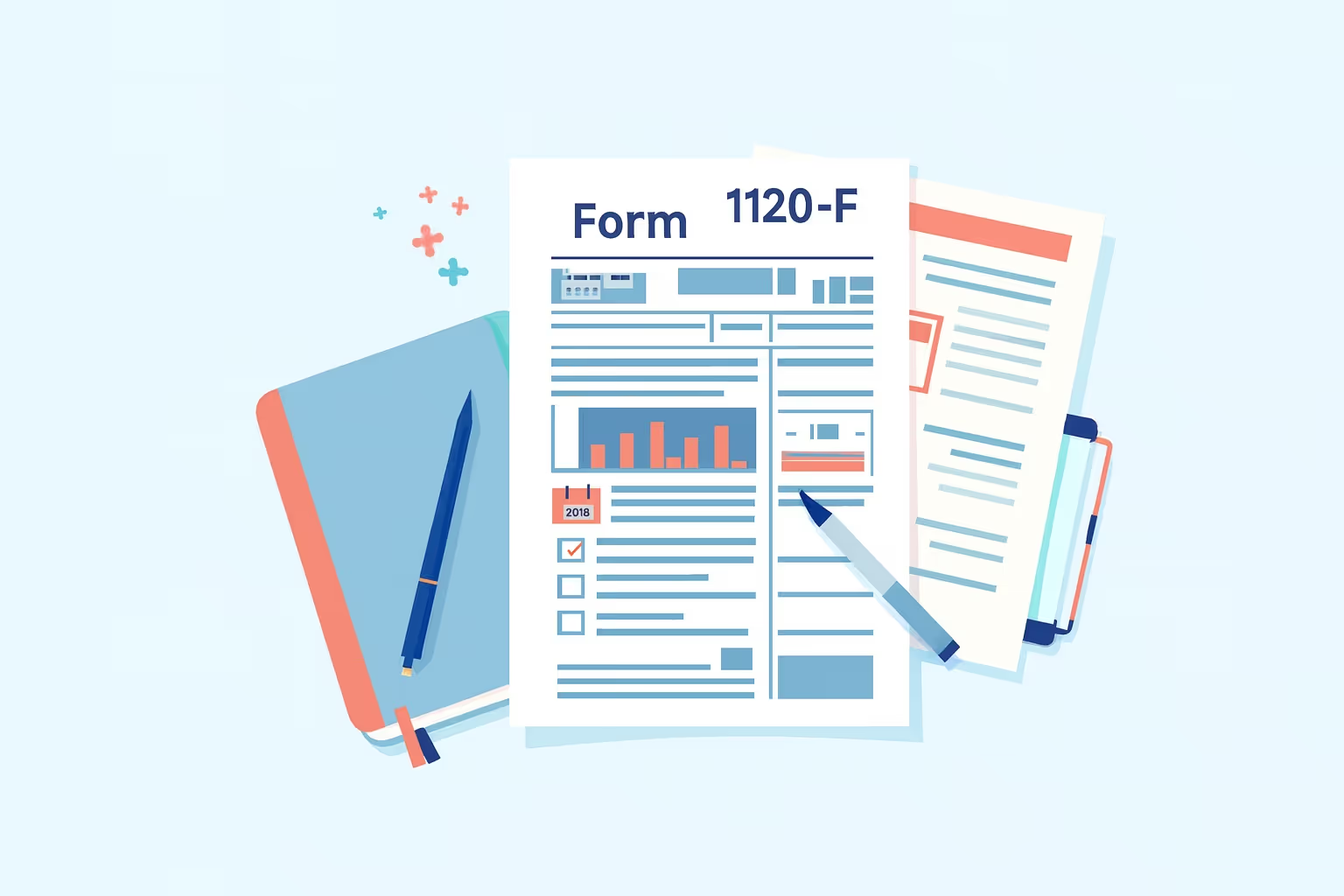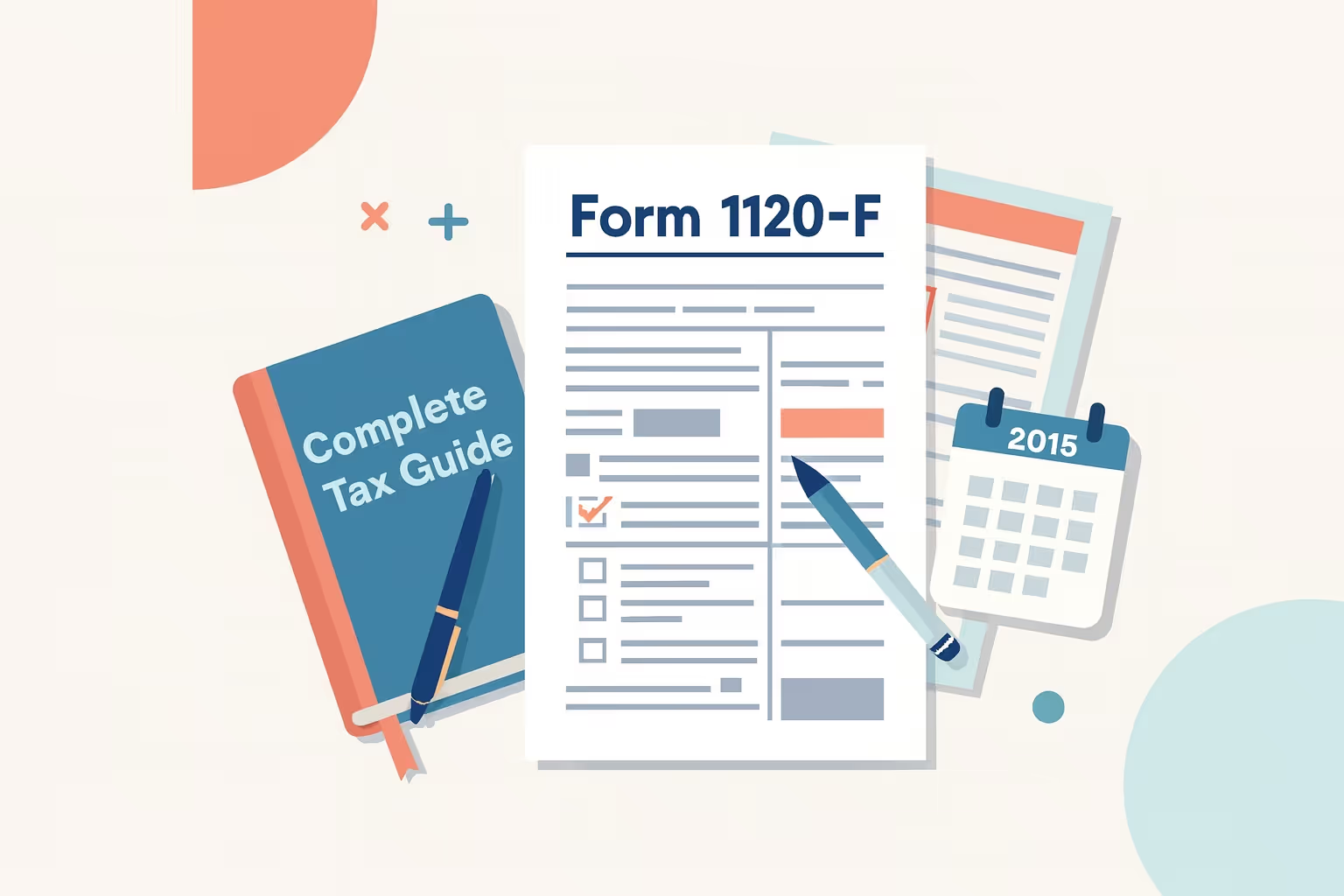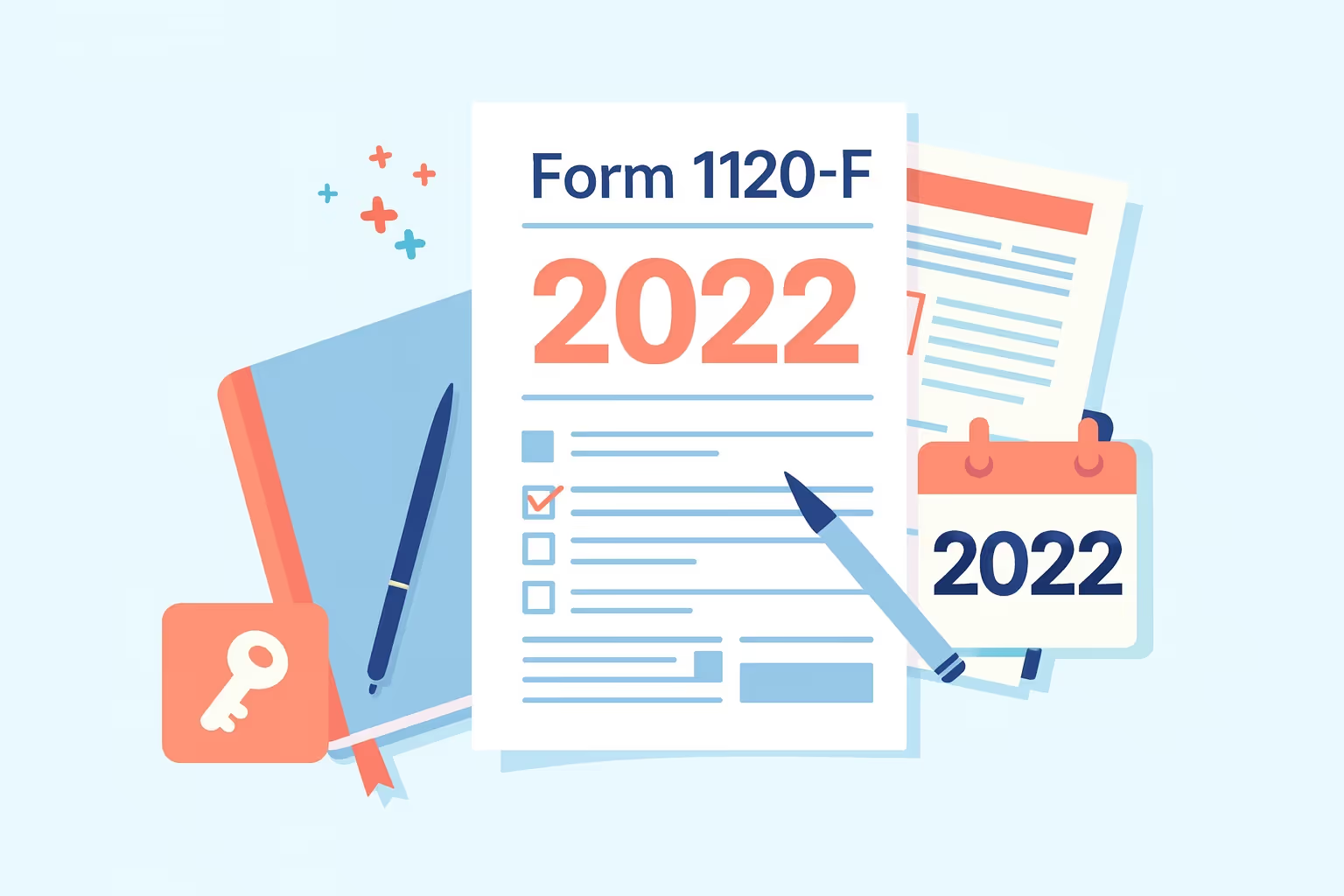Guide to Form 1120-F 2016 Instructions for Corporations
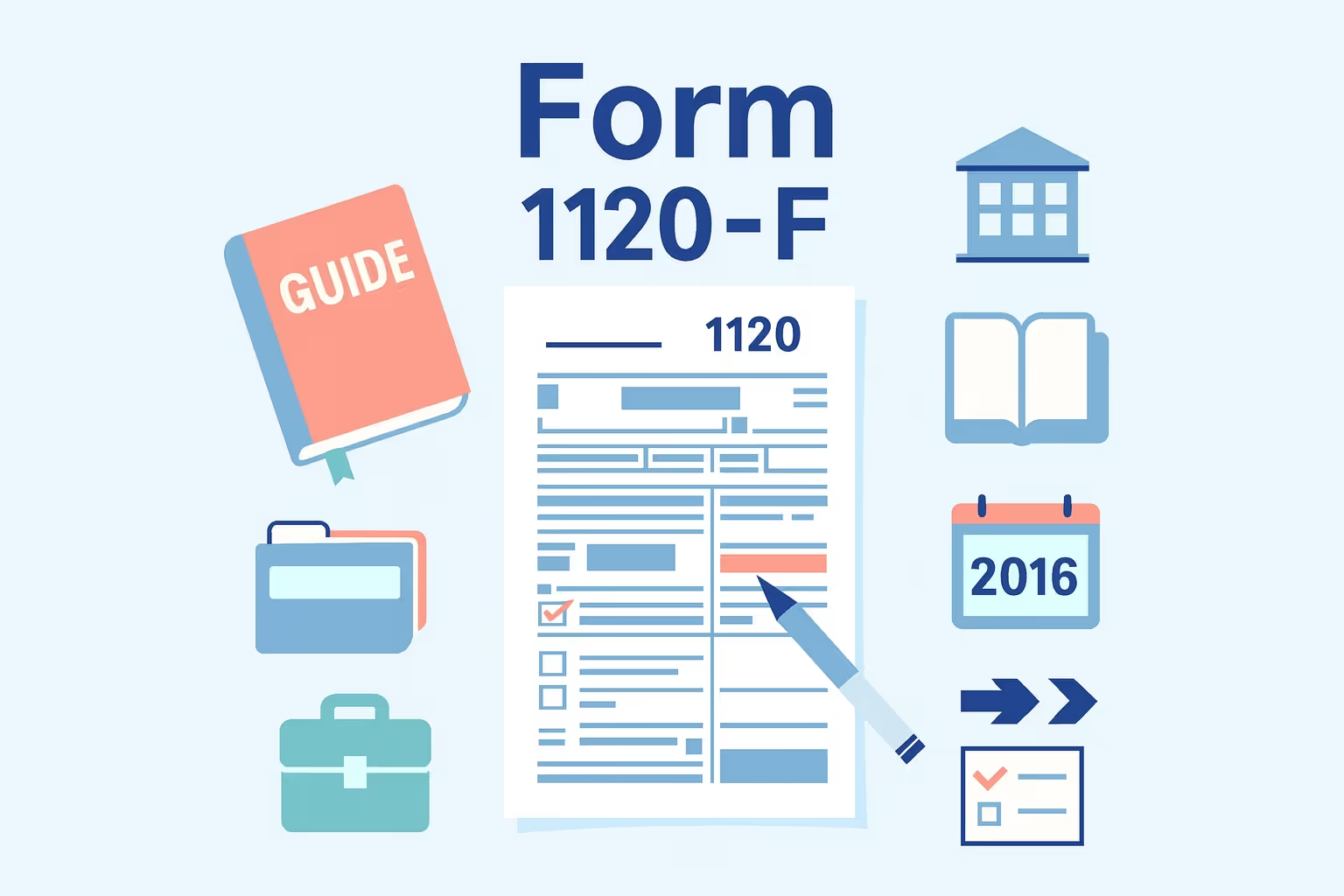
Filing an income tax return in the United States can be complex for foreign corporations. The Internal Revenue Service requires corporations engaged in U.S. trade or business to file Form 1120-F for the 2016 tax year. This article provides practical guidance to help corporations understand requirements and comply with U.S. tax law.
Foreign corporations with business income, property, employees, or other U.S.-source activities are subject to specific reporting rules. The IRS form collects income, losses, deductions, credits, and tax liability information. Filing correctly ensures compliance, helps avoid penalties, and protects the ability to claim deductions or refunds in the future.
The following sections explain the purpose of Form 1120-F, outline changes for 2016, and provide clear instructions for preparing and submitting the return. Corporations can use this article as a reference to find required forms, understand filing dates, and request assistance when needed.
Overview of Form 1120-F 2016 Instructions
Form 1120-F is the U.S. income tax return for foreign corporations that engage in trade or business within the country. It is required for corporations reporting effectively connected income, claiming credits, or requesting refunds.
Purpose of the IRS Form
- Report income: Corporations must report business income, gains, losses, and tax-exempt amounts connected with U.S. activities.
- Calculate liability: The return ensures the IRS can assess tax liability fairly under the tax law.
- Claim deductions: Filing protects rights to claim credits and deductions against effectively connected income.
- Preserve compliance: A properly filed return maintains compliance with revenue rules and avoids additional penalties.
Who Must File
- Engaged in trade: Foreign corporations engaged in U.S. business activities must file, even if income is exempt under a treaty.
- Effectively connected income: Corporations classified as effectively connected are required to submit an income tax return.
- Unsatisfied withholding: If U.S. source tax liability is not fully satisfied through withholding, filing is still required.
- Protective filing: Corporations unsure of classification may file a protective return to preserve the right to deductions.
Exceptions From Filing
- No engagement: Corporations not engaged in U.S. trade or business during the tax year are not required to file.
- Withholding met: When all U.S. tax was withheld at source by a vendor or other payer withholds all U.S. tax at source, filing may not be required.
- Exempt income: Income fully exempt under law, such as certain interest under Section 881(c), is excluded from filing.
What Changed for Tax Year 2016
Form 1120-F was modified for the 2016 tax year. Foreign corporations filing the income tax return must be familiar with new deadlines, form layout changes, and updated penalties.
New Filing Deadlines
- Corporations with offices: The deadline for corporations with offices is the 15th day of the fourth month after the end of the tax year.
- Corporations without offices: The deadline for corporations without offices is the 15th day of the 6th month after year-end, providing additional time for compliance.
- Special rule: For corporations with a June 30 year-end, the due date is the 15th day of the 3rd month.
Form Layout Changes
- Question relocation: Several identification questions were moved between pages to streamline instructions and compliance.
- New Question W(2): Corporations claiming treaty benefits based on a Competent Authority determination must provide documentation.
- New Question BB: Corporations making payments requiring Forms 1042 and 1042-S must report these under Chapter 3 or Chapter 4.
Penalty Increases
- Late filing: For returns filed more than 60 days after the required date, the minimum penalty increased to $205 or the tax owed.
- Compliance burden: Penalties apply regardless of a corporation’s income, so timely filing ensures compliance.
- IRS enforcement: Stronger enforcement encourages corporations to pay attention to filing dates and maintain accurate records.
Step-by-Step Filing Instructions
The following steps guide foreign corporations through preparing and submitting Form 1120-F. Each step highlights requirements, provides instructions, and ensures corporations comply with U.S. tax law.
Step 1: Gather Required Information
Corporations must collect all records before completing the IRS form. This includes employer identification numbers, property ownership data, payroll details, sales records, and business income information. Supporting documents such as Forms 1042-S, partnership schedules, and treaty claims are required. Organized preparation ensures accurate reporting and reduces the risk of penalties or requests for additional information.
Step 2: Determine Filing Status
Foreign corporations must establish whether they submit a regular return, a protective filing, or a final return after ending U.S. activities. Filing status affects reporting requirements, deductions allowed, and compliance obligations. Corporations unsure of their position should consider requesting professional assistance to ensure compliance with the applicable tax law and avoid unnecessary penalties.
Step 3: Complete Form Header Information
The top section of Form 1120-F requires corporations to provide identifying information. This includes the legal name, country of incorporation, date of incorporation, and employer identification number. Corporations must also indicate if the return is protective, final, or modified. Accurate information ensures proper processing by the IRS and helps avoid delays in revenue collection and refunds.
Step 4: Complete Page 1 Questions A–G
This section collects details about incorporation, country of ownership, first-year status, and elections under U.S. tax law. Corporations must provide dates, describe activities, and ensure accurate answers. The IRS uses these responses to confirm compliance, correctly classify the corporation, and determine whether certain tax law sections apply.
Step 5: Complete Page 2 Questions H–BB
Page 2 requests detailed information about the corporation’s business activities, tax-exempt income, and payments made to vendors or employees. Newly added questions for the 2016 tax year include treaty benefit claims under Competent Authority and reporting of payments requiring Forms 1042 and 1042-S. Corporations must provide complete responses to avoid penalties or requests for clarification from the department.
Step 6: Report Income in Sections I and II
Section I reports that U.S. source income is not effectively connected with a trade or business, while Section II reports that it is effectively connected to business income. Correct classification is critical because deductions are only allowed against effectively connected income. Corporations must ensure accurate allocation to preserve deductions, claim credits, and comply with U.S. tax law requirements and IRS instructions.
Step 7: Complete Tax Computation
This section calculates overall tax liability, including regular income tax, branch profits tax, and any tax on excess interest. Corporations must apply the correct rate based on the applicable section of the law. Computations must reflect losses, credits allowed, and payments already made. Careful calculations ensure compliance and reduce the risk of penalties, interest, or revenue adjustments later.
Step 8: Attach Required Schedules
Form 1120-F requires corporations to attach schedules that support deductions, interest expense allocation, and book-to-tax reconciliations. Schedules must be arranged correctly and include detailed supporting statements when needed. Missing schedules or incomplete attachments are common compliance errors. Including all forms ensures the IRS has enough information to classify income properly and process claims for refunds or credits.
Step 9: Sign and Date the Return
An authorized officer of the corporation must sign and date the return. The paid preparer’s section must also be completed if professional assistance was provided. A missing signature can cause the IRS to reject the return, delay processing, and jeopardize refunds. Proper signatures confirm responsibility for the accuracy of the reported income, tax liability, and other required information.
How to File Form 1120-F 2016 Instructions
Corporations may file Form 1120-F electronically or by paper: each filing method has specific requirements, deadlines, and benefits. Choosing the correct option ensures timely processing and compliance.
E-File Eligibility and Requirements
- Mandatory threshold: Corporations with $10 million in assets and 250 or more forms filed must e-file, ensuring compliance with IRS requirements and U.S. tax law.
- Processing speed: Electronic filing provides immediate IRS confirmation, faster processing, and fewer errors than paper filing, significantly reducing the risks of penalties or delayed revenue reporting.
- Compliance assurance: E-filing ensures corporations meet deadlines, provide accurate data, and comply with U.S. tax law, lowering risks of rejected or delayed filings.
E-File Process
- Select software: Corporations must use IRS-approved software or an authorized electronic return originator to ensure accurate reporting and compliance with instructions.
- Prepare forms: Required forms include 8879-I for signature authorization and 8453-I for corporations using internet service providers without an electronic return originator.
- Submit return: Corporations file electronically, then receive immediate acknowledgment from the IRS confirming receipt and compliance with filing requirements for the tax year.
Paper Filing
- Mailing address: Corporations using paper filing must mail returns to the IRS Service Center in Ogden, Utah, designated for foreign corporation income tax returns.
- Submission rules: Paper returns must be typed or printed in black ink, unstapled, and mailed flat to prevent damage or rejection during IRS processing.
- Proof of mailing: Corporations should use certified mail or courier services with tracking to verify delivery and compliance with IRS filing deadlines.
Filing Deadlines
- With U.S. office: Corporations maintaining a U.S. office must file by the 15th day of the 4th month after the end of the tax year.
- Without a U.S. office: Corporations without a U.S. office must file by the 15th day of the 6th month after year-end, ensuring additional time for compliance.
- June 30 fiscal year-end: Corporations with fiscal years ending June 30 must file by the 15th day of the 3rd month, reflecting modified 2016 rules.
Payment Instructions for Foreign Corporations
Corporations must pay their tax liability by the due date. Payments can be made electronically or by paper, depending on their corporate structure and compliance requirements.
When Payment Is Due
- Same deadline: Payments are due on the return due date, even if corporations file extensions, ensuring timely compliance with IRS tax law requirements.
- Extension limits: Extensions modify only filing deadlines, not payment deadlines, meaning corporations must submit payments by original due dates to remain compliant.
- Penalty risk: Late payments generate penalties and interest charges, increasing tax liability while potentially triggering additional IRS enforcement or compliance reviews.
Electronic Payment Options
- EFTPS: The Electronic Federal Tax Payment System is free and secure. It allows corporations to schedule payments online with immediate IRS confirmation.
- Direct debit: Corporations filing electronically can authorize direct bank withdrawals, ensuring scheduled payments meet IRS compliance and accuracy requirements.
- Card payments: Credit or debit card payments through third-party processors are accepted, though convenience fees apply, requiring corporations to plan carefully before payment.
Paper and Wire Payments
- Checks: Paper checks or money orders must be made payable to “United States Treasury” and mailed with returns or vouchers to the designated address.
- Wire transfers: Large corporations may use bank wire transfers for same-day payments, guaranteeing compliance with deadlines and efficient IRS receipt of funds.
- Deposit rules: Corporations with a U.S. office owing $500 or more must use electronic deposits, as paper payments may trigger penalties.
Estimated Tax Requirements
- Quarterly obligations: Large corporations must make quarterly estimated tax payments using Form 1120-W, ensuring compliance and preventing underpayment penalties.
- Safe harbor rule: Corporations meet compliance by paying the lesser of their current or prior-year tax liability in quarterly estimates.
- Planning strategy: Making timely estimated payments reduces interest charges, avoids penalties, and supports ongoing compliance with IRS requirements during the tax year.
Required Schedules and Attachments
Form 1120-F requires certain schedules and attachments depending on corporate activities. Each plays a unique compliance role, and missing items often delay processing.
- Schedule H: Corporations must use Schedule H to allocate deductions against effectively connected income, ensuring expenses are properly classified and allowed under U.S. tax law.
- Schedule I: Corporations reporting U.S. interest expenses must complete Schedule I, which ensures allocations follow Regulations Section 1.882-5 and reflect compliant calculations.
- Schedule M-1: Corporations with assets under $10 million must file Schedule M-1, reconciling book and taxable income for accurate corporate compliance reporting.
- Schedule M-3: Corporations with assets of $10 million or more must file Schedule M-3, providing detailed reconciliations required for IRS verification of reported income.
- Schedule P: Corporations with partnership interests producing effectively connected income must complete Schedule P, ensuring transparency in reporting shared U.S. business activities.
- Schedule S: Corporations claiming exemptions for international transportation must attach Schedule S, which documents eligibility under Section 883 provisions of U.S. tax law.
- Schedule W: Corporations claiming credits or refunds for withheld amounts under Chapters 3 and 4 must file Schedule W, ensuring correct IRS recognition of credits.
Common Mistakes to Avoid
Accuracy is critical when filing Form 1120-F. The following mistakes frequently delay processing, increase liability, or trigger IRS penalties against foreign corporations.
- Incorrect EIN: Using a wrong or missing employer identification number results in rejection, delayed processing, and compliance problems requiring correction by the IRS.
- Wrong address: Filing at an incorrect IRS service center delays processing, causes misplaced records, and increases penalty exposure under tax law requirements.
- Missing signature: Submitting unsigned returns causes the IRS to treat them as unfiled, resulting in penalties, lost refunds, and compliance reviews.
- Income misclassification: Misclassifying FDAP and ECI income results in disallowed deductions, increased liability, and greater corporate compliance risks.
- Deduction errors: Claiming deductions without proper allocation to ECI results in disallowance, higher liability, and potential IRS enforcement actions.
- Missing schedules: Omitting schedules such as H, I, or M-3 creates incomplete filings and results in compliance notices.
- Unsupported credits: Claiming credits without supporting documentation leads to denial, delayed refunds, and heightened IRS scrutiny.
Zero Activity or Dormant Years
Even corporations without income may still need to file. Filing a zero or protective return preserves deductions, ensures compliance, and prevents future exposure to penalties.
- Zero returns: Corporations engaged in U.S. trade or maintaining an office must file a zero return, even when no business income was earned during the year.
- Protective returns: Corporations unsure of activity classification should file protective returns to preserve deductions and credits if the IRS later determines taxable business involvement.
- Consequences: Failure to file causes loss of deductions, increased liability, compliance risks, and exposure to penalties or audits in future tax years.
First-Time Filer Tips
First-time filers face challenges understanding IRS rules. Proper preparation, documentation, and awareness of deadlines ensure compliance and reduced risk of penalties or delays.
- Obtain EIN: Corporations must apply for an employer identification number online, by phone, or through Form SS-4, ensuring proper identification before filing.
- Review treaties: Reviewing tax treaties with the corporation’s home country helps identify available exemptions, reduced withholding rates, and compliance opportunities under U.S. tax law.
- Keep records: Corporations must maintain payroll, property, and income records for at least three years to ensure accuracy and readiness for IRS audits.
Effectively Connected Income (ECI) vs FDAP
Under U.S. tax law, the classification between effectively connected income (ECI) and fixed, determinable, annual, or periodical (FDAP) income determines deductions, tax rates, and corporate liability.
- FDAP defined: FDAP includes passive income such as dividends, royalties, rents, or interest, taxed at 30 percent gross with no deductions allowed.
- ECI defined: Effectively connected income includes U.S. business operations and asset sales, taxed at graduated rates, allowing deductions and credits under IRS rules.
- Connection tests: Income may be treated as ECI under asset-use or business-activities tests, which assess links between U.S. operations and generated income.
Treaty Positions and IRS Form 8833
Tax treaties can reduce or eliminate liability. Filing Form 8833 when required ensures corporations maintain transparency, compliance, and eligibility for treaty-based tax benefits.
- When treaties apply: Corporations must be residents of treaty countries to qualify for benefits such as exemptions, reduced rates, or permanent establishment exclusions.
- Form 8833 requirement: Corporations must file Form 8833 when claiming treaty-based positions that reduce liability, ensuring compliance with IRS reporting rules and transparency.
- Competent Authority: Question W(2) requires corporations claiming treaty benefits from Competent Authority determinations to attach documentation verifying eligibility under U.S. tax law.
Branch Profits Tax
The branch profits tax under Section 884 simulates dividend treatment for branches. It applies when foreign corporations earn U.S. business income without treaty exemptions.
- Application: Branch profits tax applies when corporations report effectively connected earnings and profits, unless exempt under applicable treaties with the United States.
- Calculation: The dividend-equivalent amount equals effectively connected earnings, adjusted by changes in U.S. net equity, determining liability for branch profits tax.
- Treaty relief: Tax treaties often reduce or eliminate branch profits tax, but corporations must prove residency and comply with limitation-on-benefits provisions.
Frequently Asked Questions
Do I need to file Form 1120-F if I had no income but kept a U.S. office in 2016?
Yes, corporations with a U.S. office must file even without income. Filing preserves deduction rights, maintains compliance, and protects against penalties. A protective return ensures corporations remain eligible for refunds or credits, reducing risks from future IRS determinations that activities constituted taxable U.S. business operations under federal tax law requirements.
How do I tell FDAP from ECI for reporting on Sections I and II?
FDAP includes passive income such as dividends, royalties, and interest, taxed at 30 percent with no deductions. Effectively connected income arises from U.S. business operations and is taxed at graduated rates with deductions. Corporations must apply asset-use and business-activities tests when determining classification, ensuring compliance and avoiding penalties or misreporting under IRS tax law.
What are the 2016 due dates for corporations with and without a U.S. office?
Corporations with a U.S. office must file by the 15th day of the 4th month after year-end. Those without an office file by the 15th day of the 6th month. Fiscal-year corporations ending June 30 must file by the 15th day of the 3rd month, reflecting modified IRS deadlines for the 2016 tax year.
When is Form 8833 mandatory with Form 1120-F?
Form 8833 is required when corporations take treaty positions reducing or eliminating liability, including permanent establishment exemptions or reduced withholding rates. Some exceptions apply, but failure to file Form 8833 when required results in penalties. Proper submission ensures transparency, accurate reporting, and recognition of treaty-based benefits under IRS instructions and U.S. federal tax law.
How does treaty relief affect the branch profits tax for 2016 filers?
Treaty relief can reduce or eliminate branch profits tax for corporations qualifying under the limitation-on-benefits provisions. Eligibility depends on the language of the treaty and proof of residency. Proper documentation ensures recognition of relief and compliance with IRS requirements. Without a treaty, corporations must calculate liability based on effectively connected earnings and profits, paying branch profits tax under Section 884.
What documents support withholding credits reported on Forms 1042-S?
Corporations must attach Forms 1042-S when claiming withholding credits, proving taxes were withheld at the source. Missing forms lead to denied credits and delayed refunds. Complete documentation ensures recognition of credits, maintains compliance, and reduces IRS challenges. Corporations should verify that all withholding forms are attached before filing to ensure accurate processing and refund eligibility.
Can I e-file if I do not meet the mandatory e-file thresholds?
Yes, corporations below mandatory thresholds may e-file voluntarily. Electronic filing provides immediate IRS confirmation, faster processing, and reduced errors compared with paper filing. The IRS encourages voluntary e-filing for efficiency and compliance benefits. Choosing e-file allows corporations to meet requirements accurately while simplifying recordkeeping, ensuring convenience, accuracy, and reduced risks for corporate filers.
















